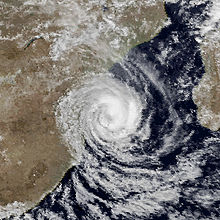- Tropical Storm Domoina
-
Moderate Tropical Storm Domoina Moderate tropical storm (MFR) Tropical Storm (SSHS) 
Moderate Tropical Storm Domoina at landfall on Mozambique Formed January 19, 1984 Dissipated January 30, 1984 Highest winds 10-minute sustained:
75 km/h (45 mph)
1-minute sustained:
95 km/h (60 mph)Lowest pressure 976 mbar (hPa; 28.82 inHg) Fatalities 214[1] Damage $221.1 million (1984 USD) Areas affected Madagascar, Mozambique, Swaziland, South Africa Part of the 1983–84 South-West Indian Ocean cyclone season Cyclone Domoina (also spelt Demoina) was a tropical cyclone that hit southern Africa in early 1984, causing some of the most severe flooding so far recorded in the region.
Contents
Meteorological history
Cyclone Domoina began in the Indian Ocean to the north-east of Madagascar on 19 January 1984.[2]
The cyclone crossed Madagascar from east to west between Antanarivo and Antsirabe from 22 January to 24 January 1984 and moved into the Mozambique channel where it crossed just south of the Comoros around 26 January 1984.[2] Domoina made landfall in southern Mozambique on 28 January 1984,[2][3]and moved slowly south, with heavy rainfall over northern KwaZulu-Natal, Mpumalanga and Swaziland until 1 February 1984.[3]
The St Lucia lake and estuarine system in northern KwaZulu-Natal, South Africa was struck by Cyclone Domoina on 31 January 1984.[4] Cyclone Domoina reached as far south as Durban,[5] and associated weather caused severe flooding all along the south coast of KwaZulu-Natal, to Port Edward.
Damage and loss of Life
Cyclone Domoina resulted in the loss of 214 human lives,[1] and the lives of countless livestock and wildlife. Several bridges were washed away by the flood-waters in KwaZulu-Natal, including the bridge connecting the town of St Lucia to the mainland,[6] Major geomorphological changes occurred at the mouth of Lake St Lucia, where all man-made structures were obliterated as the two river channels at the mouth were scoured from 2–3 metres (6 ft 7 in–9 ft 10 in) to 10–14 metres (33–46 ft) in depth and widened by up to 300 metres (980 ft), while the shoreline between the two channels retreated in places up to 100 metres (330 ft), with an estimated 16,000,000 cubic metres (570,000,000 cu ft) of sediment being removed from the lower reaches of the system.[7] Conversely; a large lobe of sediment ~10 kilometres (6.2 mi) long and average 3 kilometres (1.9 mi) wide was deposited on the upper Mfolozi flood-plain[5] as the Mfolozi River avulsed from its former course into the southern Msunduzi River near the floodplain head. [8] Holiday-makers in Port Edward had to travel inland to Kokstad, past the southern Drakensberg, and down through the KwaZulu-Natal Midlands to return to their homes in the Durban area.[9]
Hydrology
Storm centres with precipitation exceeding 700 millimetres (28 in) over 28 January to 2 February occurred over upper Umfolozi, Mkuze, Pongolo and middle Usutu and Komati rivers.[3]
The Ingwavuma tributary had 700 millimetres (28 in) of rainfall in both the upper and lower reaches.[3]Discharge on the Umfolozi river reached 16,000 cubic metres per second (570,000 cu ft/s), which is about 3 times the 100 year return flood,[5] while flow velocities of 2.6 metres per second (8.5 ft/s) were measured.[10][11]
Ecological Consequences
The flooding caused by Domoina on the Umfolozi Rivers destroyed ancient riverine forests.[12] Large areas of mangrove and Phragmites australis swamps were destroyed in the lower reaches of the Lake St Lucia system by the floodwaters, and mangrove saplings also died from inundation lasting days to weeks.[7] Effects on the fauna included range redistribution of the tanaid Apseudes digitalis, the mysid Mesopodopsis africana, the copepod Pseudodiaptomus stuhlmanni, the polychaete Scololepis squamata and the bivalve Solen cylindraceus, which previously appeared in the tidal channel linking the lake with the sea.[7] A rapid salinity decrease of around 25% had a direct, short-term effect on most components of the benthos of Lake St Lucia, as well as a long-term effect on the bivalves, particularly Solon cylindraceus, which species was unable to re-establish itself at previous densities.[13] Responses of other species such as penaeid prawns, the crab Scylla serrata and the sole Solea bleekeri suggested that physiological tolerance, extended larval or juvenile recruitment periods and food source switching minimized long-term flood effects.[7] Indirect long-term effects were noted in the diet of Solea bleekeri, which feeds predominantly on the siphon tips of S. cylindraceus, in that it switched to feeding on other prey at the surface of the benthos.[13]
See also
References
- ^ a b "STATEMENT ON THE CELEBRATION OF THE INTERNATIONAL DECADE FOR NATURAL DISASTER REDUCTION ON WEDNESDAY, 14 OCTOBER 1998.". Government of South Africa. http://www.info.gov.za/speeches/1998/98a14_0x4909811240.htm. Retrieved 6 June 2010.
- ^ a b c "Season 1983-1984 Tropical Cyclone DOMOINA Track Map". Australia Severe Weather. http://www.australiasevereweather.com/tropical_cyclones/1983_1984/jtwc/tropical_cyclone_domoina.htm. Retrieved 6 June 2010.
- ^ a b c d "The effects of the Domoina floods and releases from the Pongolapoort Dam on the Pongolo floodplain". Department of Water Affairs (South Africa). http://www.dwa.gov.za/iwqs/reports/tr/B-N3_0704_Domoina%20floods%20and%20the%20Pongolo%20floodplain.pdf.
- ^ Impact of a major cyclone on a southeast African estuarine lake system Forbes A.T. and Cyrus D. P. University of Natal
- ^ a b c "Geomorphology and dynamics of the Mfolozi River floodplain, KwaZulu-Natal, South Africa". http://eprints.ru.ac.za/1467/1/Geomorphology_and_dynamics.pdf. Retrieved 6 June 2010.
- ^ http://kingspalace.co.za/important-dates/
- ^ a b c d Forbes, A.T. and Cyrus, D.P. Impact of a major cyclone on a southeast African estuarine lake system. University of Natal, Durban
- ^ van Heerden, 1984
- ^ Purves et al. 2010
- ^ Tavers, 2006
- ^ Geomorphology and Dynamics of the Mfolozi River Floodplain, KwaZulu-Natal, South Africa. Grenfell S.E. Rhodes University, Grahamstown. http://eprints.ru.ac.za/1467/1/Geomorphology_and_dynamics.pdf
- ^ Pooley, E. 1993
- ^ a b Netherlands Journal of Sea Research Volume 30, December 1992, Pages 265-272, Proceedings of the 26th European Marine Biology Symposium Biological Effects of Disturbances on Estuarine and Coastal Marine Environments, Episodic events and estuaries: effects of cyclonic flushing on the benthic fauna and diet of Solea bleekeri (Teleostei) in Lake St Lucia on the south-eastern coast of Africa. D. P. CYRUS
Categories:- 1983–84 South-West Indian Ocean cyclone season
- Moderate Tropical storms
Wikimedia Foundation. 2010.

